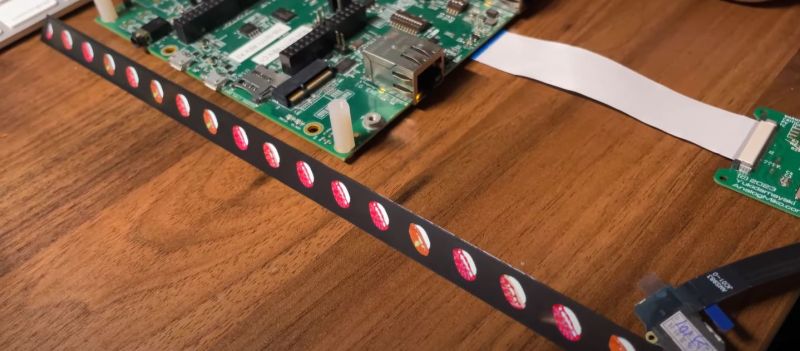The Apple Touch Bar was an oddity on a fairly small number of Apple laptops which replaced the function key row with a touch display. Yet what is special about this display other than its odd form factor when you consider it as a generic touch display? As [Wenting Zhang] describes in a recent reverse-engineering video, this 2,170 x 60 pixel display is somewhat limited in that it doesn’t support the MIPI DSI video mode, only command mode, along with a special instruction (0x3C) for automatic address offsets. The results of this project can be found on the GitLab account.
In a way these limitations make sense when you consider Apple’s use case for these special MIPI-DSI displays. As a touch screen with dynamic controls being displayed on it, features such as video playback never were a goal, and thus Apple likely decided to save a few bucks, possibly also due to MIPI licensing costs. What this means is that if you had dreamed of snapping up an extremely long and narrow OLED display for a video project you’re in for somewhat of a bad time. Although animated content is possible – as [Wenting] demonstrates – this comes with all the limitations of command mode, meaning slower updates, higher power usage and a lot more overhead.
Thanks to [John Little] for the tip.

















Sorry I wasn’t making it clear in the video… it’s still totally possible to do 60Hz video with command mode only, Apple is doing that on the MacBook after all. In addition it has Vsync output so it’s possible to synchronize the command write with the screen update to achieve tearing free display. Command mode doesn’t necessarily use more power or add more overhead, but it’s indeed a bit awkward to see a MIPI screen without video mode support, and could cause some compatibility issues with SoCs that only support video mode screens.
The great obliterator of “proprietary” in display tech himself is here :) I just wanted to say your youtube channel is an abolute treasure, especially the epaper stuff! Very impressive what you can do with just so little initial information. Great content and great presentation.
My complements to [Wengting] for the valiant attempt to establish an interface with an Apple Touch Bar.
However, I dislike Youtube commentators that don’t seem to take a breath between sentences. While I’m certain that [Wenting] had something important to say, I’m not certain what it actually was.
I’m impressed that [Wenging] managed to get the Apple Touch Bar to do something, but I’m still left with the question as to exactly what was accomplished. I gather, from the video, that [Wenging] managed to get the Apple Touch Bar to display in a controllable manner; however I’m uncertain as to whether or not [Wenting] managed to do anything more.
I would have appreciated a more detailed (and less breathless) exposition on the experiment than I saw in the video. What I saw would be of no help to me if I were to attempt to interface with an Apple Touch Bar.
He figured out how to drive a screen without a datasheet of the screen and with only a bootleg copy of the interface specification. Information about diy mipi dsi is rare, and I’m thankful for everything I can get. The last display hack I know of it mikes eclectric stuff video on the iPod nano 6 display from about 10 (!) years ago.
In general o dislikenvideos for their blown information density, as creators like to pad with fluff. I appreciate that Wenging doesn’t do that. Your inability to understand what he says must be a skill issue.
I watched it at 1.5 times speed and understood it perfectly well. Are you sure your dislike that you mention, is in fact not a dislike of the sound of a foreign person speaking English (and doing an excellent job of it)?
Cool hack, would be a nice accessory on a standard keyboard 👍
I have a Macbook with this bar. But seriously, the bar sucks as a replacement for actual keys. Its one big problem is that you just can’t feel where the keys are. Close your eyes, try to tap the right key.
What people don’t realise is that if they want to tap e.g. the ESC key, they actually feel for the key on the keyboard. They swipe the keyboard until they feel the key and then press it. Same with function keys, they come in groups of 4 with extra space in between.
Now you try to blindly ‘find’ the ESC ‘key’ on the touch bar, without accidentally selecting any of the other function ‘keys’…
You just can’t operate a touch bar without having to put your eyes on the keyboard.
Also, the touch bar becomes utterly useless when you use the laptop as a desktop computer: in a stand, with an extra monitor and separate keyboard.
But that last problem could indeed be solved by hacking a touch bar in your separate keyboard. But the first problem cannot.
Let’s not forget that Apple added a physical escape key on later Touchbar model Macbooks. The doesn’t change the fact you have to look at your keyboard to use the TB itself, but at least they listened to the complaints about the esc key :)
So much useful info on that Youtube channel, thank you for sharing.
This seems like a nice project once my 2017 MBP inevitably breaks beyond repair. I’m not gonna be the one to try to fix the soldered on SSD!